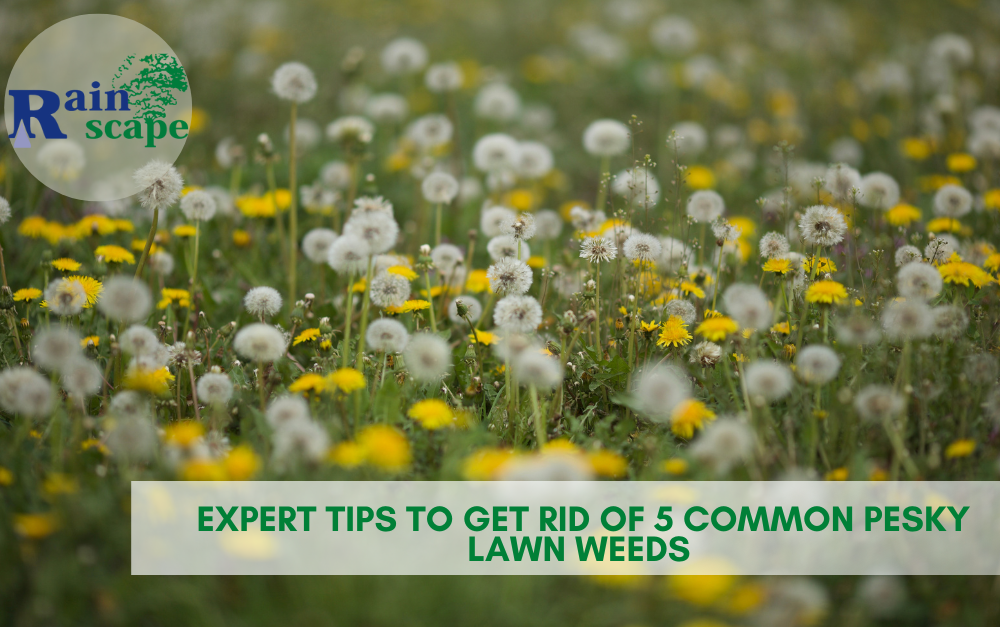Weeds, weeds go away, please don’t come back another day! Are those pesky lawn weeds getting you down? Our lawns provide the perfect home for many unwanted plants, aka weeds. We have compiled a list of 5 common weeds and ways to manage them that work.
Prostrate Knotweed
The knotweed is an annual summer weed that thrives in compact soils. This common weed grows low to the ground and spreads its wiry stems and blue-green leaves. The weed has swollen areas called nodes which look like small knots, hence their name.
How do you get rid of knotweed? One thing that knotweed doesn’t like is regular aeration. If you aerate your soil, you’ll make it less inviting. You can handpick any stragglers. If you do need to resort to chemical means you can use an iron-based herbicide. If you apply professional pre-emergent weed control in late winter or early spring it’ll prevent them from establishing.
Crabgrass
Crabgrass is an annual that completes its life cycle in one year. The crabgrass has stems that spread out and hug the ground, like ocean crab legs. The crabgrass seeds germinate in spring and grown before the warm-season lawn starts.
How do you get rid of crabgrass? You can limit seed production by mowing your lawn regularly in late summer when it’s beginning to produce seedheads. Having a healthy, and dense lawn is an easy way to prevent crabgrass from taking root. If you do need to target problem areas, you can use a pre-emergent herbicide that is either organic or synthetic. One important note is that you will not want to use this herbicide when you plan to seed grass, because it will prevent all seedlings from germinating. The herbicide is designed to kill seedlings before they can establish. For it to be the most effective you’ll need to apply it when your soil is 50 to 60 degrees Fahrenheit.
Chickweed
Chickweed has tiny fuzzy leaves and small white flowers in the spring. Chickweed is a winter annual, and it produces hundreds of seeds. Preventing seeds from setting is key to control.
How do you get rid of chickweed? You can pull it by hand if you see it, but it’s often low growing and hidden in the turf. The window for control is very short as they flower quickly after they germinate. An iron-based herbicide applied in late fall or early winter is the best way to prevent/control chickweed.
Henbit
Henbit is often easily recognizable by its purple flowers that appear among its upper leaves. Henbit is a winter annual or biennial that invades lawns in fall and winter.
How do you get rid of henbit? Having a dense turf is the best defense against henbit. Choose a turfgrass adapted to the Visalia area and be sure to properly fertilize, mow and water to encourage dense growth. In the summer and fall you would water deep and infrequently. The weeds seeds prefer moisture near the soil surface to germinate, and you can prevent that. You can apply an iron-based herbicide every three to four weeks to young and actively growing weeks in spring or fall for optimal control.
Dandelion
As a child, many of us used these perennial weeds to make a wish as we blew on them and scattered them in the air. As homeowners, we may be less keen to see the dandelion on our manicured lawns, with its deep tap root that is difficult to pull out by hand.
How do you get rid of dandelions? It’s easier to pull young dandelions, and you’ll need to do this before they go to seed and produce hundreds of seeds. Dandelions thrive in sparse and thin lawns. If you regularly overseed and keep your lawn dense it will reduce germination. Grass clippings left on your lawn will help prevent germination while benefiting your lawn. You can also use iron-based herbicide and pre-emergent products for dandelion control.
Creating a beautiful landscape and preventing weeds takes some effort, but it is well worth it in the long run. We, at Rainscape, are happy to help you with your landscape needs and to answer any questions you might have regarding the best type of turf for your property.

